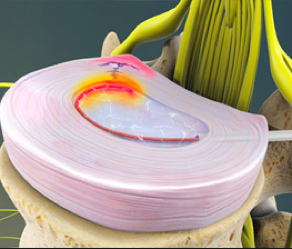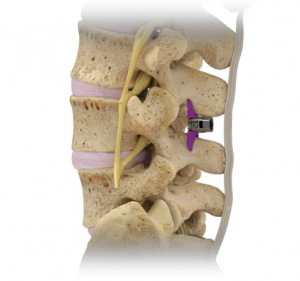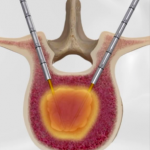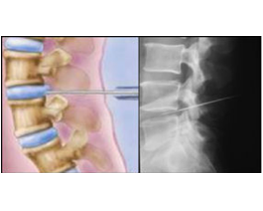At Cell Bionics Institute, we offer the latest and most advanced minimally-invasive pain management techniques. Our board-certified surgeons treat patients using modern, state-of-the art equipment and treatments that are not available elsewhere. We feature a one-day surgical center in Northern Virginia that was designed specifically to treat patients who are seeking minimally invasive alternatives to traditional surgery for healing and pain management. Our single specialty medical professionals provide surgical services in an efficient and friendly manner. The following are some of the treatments and therapies that we provide:

This is a procedure for patients that have a small disc herniation that may be the cause of persistent arm or leg pain. The surgeon removes a certain amount of the disc (this is the gel-like substance that is in between the vertebrae of the spine). This is done to release pressure and the herniation. It is done under X-ray guidance and a part of the center of nucleus (the middle of the disc) is removed by a process called ablation (which is a process of removing material from the surface of the targeted tissue). After recovery, an individual should have less pressure put on the nerve or ligaments of the spine.This procedure is reserved for patients that have persistent leg pain and have not responded well to other conservative therapies such as injections, medications, physical therapy, and/or chiropractic care.
] Also known as Percutaneous Discectomy, is a procedure used to treat pain caused by herniated discs. This is done by X-ray guidance, with small incisions, few risks of complication and a shorter overall recovery period. Small amounts of tissue from the disc are removed to relieve pressure on the nerves. This procedure is best for individuals suffering from chronic back pain and loss of/limited mobility due to a herniated disc(s) (such as inability to bathe, dress, or walk). Nucleoplasty is a suggested method of treatment once other conservative treatments have failed. These include oral medications, back brace, and bed rest.
Also known as Percutaneous Discectomy, is a procedure used to treat pain caused by herniated discs. This is done by X-ray guidance, with small incisions, few risks of complication and a shorter overall recovery period. Small amounts of tissue from the disc are removed to relieve pressure on the nerves. This procedure is best for individuals suffering from chronic back pain and loss of/limited mobility due to a herniated disc(s) (such as inability to bathe, dress, or walk). Nucleoplasty is a suggested method of treatment once other conservative treatments have failed. These include oral medications, back brace, and bed rest.
“] This is an alternative treatment to invasive surgical procedures for chronic low back pain caused by degenerative disc disease or disc hernation. The procedure involves the insertion of a catheter into the disc, followed by heating up the disc. The goal of this is to use heat to disrupt or destruct inflammatory pain mediators in the disc tissue, while also inducing collagen tissue production to seal up painful tears in the disc and stimulating new collagen formation. The entire procedure takes around an hour and the patient can go home the same day. In order to determine if you are a candidate, a discogram test must be ordered to determine if there are abnormal discs that are to be the cause of a patients back pain.
This is an alternative treatment to invasive surgical procedures for chronic low back pain caused by degenerative disc disease or disc hernation. The procedure involves the insertion of a catheter into the disc, followed by heating up the disc. The goal of this is to use heat to disrupt or destruct inflammatory pain mediators in the disc tissue, while also inducing collagen tissue production to seal up painful tears in the disc and stimulating new collagen formation. The entire procedure takes around an hour and the patient can go home the same day. In order to determine if you are a candidate, a discogram test must be ordered to determine if there are abnormal discs that are to be the cause of a patients back pain.
 The Intracept Procedure was developed to help manage chronic lower back pain. This is achieved by sending an electrical current, targeting the basiverterbal nerve (a nerve found to be directly correlated with sending pain signals), which helps to reduce pain signals. This procedure is not meant for individuals that suffer from severe cardiac or pulmonary illnesses, those who are pregnant, people who suffer from an active infection, those under the age of 18 who are still developing and growing, and people with pacemakers, defibrillators, or other electronic implants. Ideal candidates for this procedure are those that suffer from low back pain for at least 6 months or longer and have not positively responded to other conservative pain relief treatments. As with any other surgical procedure, there are risks associated with the Intracept Procedure. For more information, click here.
The Intracept Procedure was developed to help manage chronic lower back pain. This is achieved by sending an electrical current, targeting the basiverterbal nerve (a nerve found to be directly correlated with sending pain signals), which helps to reduce pain signals. This procedure is not meant for individuals that suffer from severe cardiac or pulmonary illnesses, those who are pregnant, people who suffer from an active infection, those under the age of 18 who are still developing and growing, and people with pacemakers, defibrillators, or other electronic implants. Ideal candidates for this procedure are those that suffer from low back pain for at least 6 months or longer and have not positively responded to other conservative pain relief treatments. As with any other surgical procedure, there are risks associated with the Intracept Procedure. For more information, click here.
 This is a minimally invasive procedure that is done through a tubular device and is performed for the relief of pain (in the mid-back, lower back, legs, arms, and/or neck) caused by herniated discs. It is one of the most effective surgical techniques for treating spinal disc herniation, with no need to remove bones or muscles in order to remove herniated material and alleviate the associate pain. The surgeon can see the spine through a camera lens that is inserted through a port. This procedure is performed in conjunction with Needle Arthroscopic Imaging, which allows for imaging capability of the joint space and to better visualize the internal anatomy of the joint. Usually the entire procedure takes less than an hour and the patient is able to go home after a short recovery period of around two to three hours. For a detailed video explanation, click here.
This is a minimally invasive procedure that is done through a tubular device and is performed for the relief of pain (in the mid-back, lower back, legs, arms, and/or neck) caused by herniated discs. It is one of the most effective surgical techniques for treating spinal disc herniation, with no need to remove bones or muscles in order to remove herniated material and alleviate the associate pain. The surgeon can see the spine through a camera lens that is inserted through a port. This procedure is performed in conjunction with Needle Arthroscopic Imaging, which allows for imaging capability of the joint space and to better visualize the internal anatomy of the joint. Usually the entire procedure takes less than an hour and the patient is able to go home after a short recovery period of around two to three hours. For a detailed video explanation, click here.
 This is a diagnostic test done to examine the intervertebral discs of the spine and determine any injuries or damages to the disc(s). This procedure is used to evaluate back pain. It involves injecting a dye into the center of the disc in order for the disc to be seen on X-ray or a CT scan. For more information, click here.
This is a diagnostic test done to examine the intervertebral discs of the spine and determine any injuries or damages to the disc(s). This procedure is used to evaluate back pain. It involves injecting a dye into the center of the disc in order for the disc to be seen on X-ray or a CT scan. For more information, click here.
 A minimally invasive procedure that can help individuals diagnosed with lumbar spinal stenosis (LSS) to be able to stand for longer periods of time and to have more mobility with less pain. Lumbar Spinal Stenosis is caused by pressure of the spinal nerves in the lower back and can lead to leg pain and/or tingling and numbness. This procedure is short and only involves a tiny incision with no general anesthesia. For more information, click here.
A minimally invasive procedure that can help individuals diagnosed with lumbar spinal stenosis (LSS) to be able to stand for longer periods of time and to have more mobility with less pain. Lumbar Spinal Stenosis is caused by pressure of the spinal nerves in the lower back and can lead to leg pain and/or tingling and numbness. This procedure is short and only involves a tiny incision with no general anesthesia. For more information, click here.
 The Superion InterSpinous Spacer (ISS) is a treatment for skeletally mature patients that suffer from pain, numbness, and/or cramping in the legs. Individuals that suffer from impaired physical function and only experience relief in flexion (or in the seated position) from symptoms of the leg/buttock/groin pain, numbness, and/or cramping, with or without back pain, and who have undergone at least 6 months of non-operative treatment. It is a minimally invasive approach to treat lumbar stenosis and it is implanted through a small tube the size of a dime to reduce tissue damage and blood loss. It’s a simple outpatient procedure with a rapid recovery time and no destabilization of the spine.
The Superion InterSpinous Spacer (ISS) is a treatment for skeletally mature patients that suffer from pain, numbness, and/or cramping in the legs. Individuals that suffer from impaired physical function and only experience relief in flexion (or in the seated position) from symptoms of the leg/buttock/groin pain, numbness, and/or cramping, with or without back pain, and who have undergone at least 6 months of non-operative treatment. It is a minimally invasive approach to treat lumbar stenosis and it is implanted through a small tube the size of a dime to reduce tissue damage and blood loss. It’s a simple outpatient procedure with a rapid recovery time and no destabilization of the spine.
 This procedure can take less than ten minutes to perform in the examination room. A needle is inserted into the spinal canal through a small incision and tube (cannula) for guidance to the targeted area. This imaging capability allows for illumination of the condition (such as imaging of the facet joints) and to assist with better imaging and visualization of the internal anatomy. Cell Bionics Institute is one of the only centers in this region using this system to visualize the spine. This system is used in conjunction with joint treatments, such as evaluations of joints throughout the body to further detect anomalies that an MRI might not be able to detect accurately and more accurate visualization of the evaluation and healing status such as the spinal disc after a surgical procedure. For more information, click here.
This procedure can take less than ten minutes to perform in the examination room. A needle is inserted into the spinal canal through a small incision and tube (cannula) for guidance to the targeted area. This imaging capability allows for illumination of the condition (such as imaging of the facet joints) and to assist with better imaging and visualization of the internal anatomy. Cell Bionics Institute is one of the only centers in this region using this system to visualize the spine. This system is used in conjunction with joint treatments, such as evaluations of joints throughout the body to further detect anomalies that an MRI might not be able to detect accurately and more accurate visualization of the evaluation and healing status such as the spinal disc after a surgical procedure. For more information, click here.
 This procedure uses radio frequency energy (heat) to destroy spinal tumors. This is a much less invasive procedure to remove tumors with smaller incisions. This procedure is beneficial for bone cancer patients that need to have tumor removal. It is not ideal for candidates that have pacemaker or other implantable devices, and it is not recommended for treatment of the cervical (neck) vertebrae.
This procedure uses radio frequency energy (heat) to destroy spinal tumors. This is a much less invasive procedure to remove tumors with smaller incisions. This procedure is beneficial for bone cancer patients that need to have tumor removal. It is not ideal for candidates that have pacemaker or other implantable devices, and it is not recommended for treatment of the cervical (neck) vertebrae.
 Medical ozone therapy is a percutaneous treatment that introduces ozone into a troubled area. One example of oxygen-ozone gas treatment is it is given via an injection into the herniated disc. A needle delivers the treatment directly into the disc, and it reduces the volume within the disc. This is due to the oxidation of proteins that are found within the gel-like center of the disc (nucleus pulposus). When disc volume is reduced, the pressure on nerves is also reduced. This, in turn, lowers the amount of pain.Besides a shorter recovery time and lower complication rate than surgery other benefits of oxygen-ozone injections include: minimally invasive, it is an outpatient procedure, it takes little time to administer and the costs associated with it are far less than surgery. Oxygen-ozone treatment is not suitable for everyone. If you have paralysis of the legs, an uncontrolled bladder, calcified discs, or spinal cord compression, then surgery is a better option.
Medical ozone therapy is a percutaneous treatment that introduces ozone into a troubled area. One example of oxygen-ozone gas treatment is it is given via an injection into the herniated disc. A needle delivers the treatment directly into the disc, and it reduces the volume within the disc. This is due to the oxidation of proteins that are found within the gel-like center of the disc (nucleus pulposus). When disc volume is reduced, the pressure on nerves is also reduced. This, in turn, lowers the amount of pain.Besides a shorter recovery time and lower complication rate than surgery other benefits of oxygen-ozone injections include: minimally invasive, it is an outpatient procedure, it takes little time to administer and the costs associated with it are far less than surgery. Oxygen-ozone treatment is not suitable for everyone. If you have paralysis of the legs, an uncontrolled bladder, calcified discs, or spinal cord compression, then surgery is a better option.
Contact our pain management center to learn more! The Spinal and Disc Treatment Solutions division of Cell Bionics Institute is committed to advanced minimally invasive surgical techniques and regenerative medicine for healing by offering non-surgical alternatives. To learn more about our offerings and whether you are a candidate for our services, schedule a consultation today: 1-703-444-5007